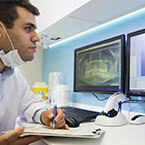Wisdom Teeth Pain, Symptoms, and Extraction

Summary
Table of Contents

This blog has been reviewed and approved by Dr Robert Lee, a dental professional of 35 years
LEARN MORE >Does Everyone Have Wisdom Teeth?
Wisdom teeth, also known as third molars, are last in line in the back of the mouth and are usually the last teeth to develop. But not all of us have our wisdom teeth, for a variety of reasons. Some humans today have smaller jaws and many of us are unable to accommodate these late-emerging teeth.
Can Wisdom Teeth Be Painful?
Most of us have four wisdom teeth, one at the back in each section of the mouth. For many people, wisdom teeth emerge from the jaw between the ages of 17 and 25 years, and they don’t cause problems. In other people, wisdom teeth can become trapped or impacted in the jawbone or simply fail to erupt. This can cause crowding or displacement of other teeth or lead to the development of localized tooth decay, infection, or gum disease. Impacted wisdom teeth are set in the jawbone in unusual positions, sometimes horizontally, which stops them from erupting in a normal way. However, impacted wisdom teeth often cause no symptoms or pain and stay within the jaw for life.
What are Wisdom Teeth Symptoms?
In some cases, the impacted wisdom tooth does cause problems. You may experience redness and swelling around the area where the tooth is impacted, as well as jaw pain, headaches, and a strange taste when you bite near the area of the impacted tooth.
Wisdom teeth are a holdover from the earlier days of humans when we ate a more primitive diet and needed more teeth. As wisdom teeth try to emerge, they can push other teeth out of the way and interfere with teeth alignment. Also, partially emerged wisdom teeth can provide a breeding ground for bacteria, and bacterial buildup can lead to infection and severe gum disease.
Does Everyone Get Their Wisdom Teeth Removed?
Even if impacted wisdom teeth are causing no symptoms, some dental professionals recommend removing them surgically to prevent the possibility of future problems. Fortunately, wisdom tooth extraction is a common outpatient procedure, performed under local anesthesia. As with any surgery, expect some residual bleeding, swelling, and bruising in the first few days after the procedure. For a few days limit your activities and rest a lot. Most people recover quickly and easily after wisdom teeth extraction. However, sometimes it takes more time to fully recover, as some extractions might be very difficult.
Wisdom teeth affected by tooth decay are required to be extracted, as they put other molar teeth in danger. Wisdom teeth decay very easily, and they can be difficult to treat (they may grow at odd angles, and they might not be accessible). Wisdom teeth decay may also cause other health issues beyond just the mouth. In fact, studies show that there is a correlation between certain oral health issues and heart disease. That is why it is important to see your dental professional right away if you experience any discomfort caused by your wisdom teeth.
How to Clean Wisdom Teeth?
Wisdom teeth infection is most of the time the result of tooth decay development. The back molars are very difficult to clean thoroughly. If your wisdom teeth grow properly, and there is no recommendation for their extraction, it’s important to continue to follow a thorough oral care routine.
- Brush your teeth twice a day with an electric toothbrush like the Oral-B iO9 which removes 100% more plaque than a regular manual brush. Plus, when you brush with the Oral-B app, you can ensure you’re covering every area of the mouth, including hard-to-reach back molars.
- Make sure to floss at least once a day. Pair traditional floss like Oral-B Glide with an oral irrigator like the Oral-B Water Flosser Advanced to further wash away any remaining plaque and food particles from between teeth.
- See your dental professional every six months for checkups and professional cleanings.
It may occasionally happen that the impacted wisdom tooth begins to cause problems. When the tissue between the tooth and the surrounding gum becomes inflamed (pericoronitis), it is advisable to thoroughly rinse out any food debris from the gum area. Your dental professional may also decide to extract the unerupted tooth to prevent further inflammation and infection.
From Oral-B, the #1 dentist-recommended toothbrush brand, worldwide.
Table of Contents
- Does Everyone Have Wisdom Teeth?
- Can Wisdom Teeth Be Painful?
- What are Wisdom Teeth Symptoms?
- Does Everyone Get Their Wisdom Teeth Removed?
- How to Clean Wisdom Teeth?
-
- Related Articles

This blog has been reviewed and approved by Dr Robert Lee, a dental professional of 35 years
LEARN MORE >
Sign Up
for expert advice and exclusive offers

Sign Up
for expert advice and exclusive offers






